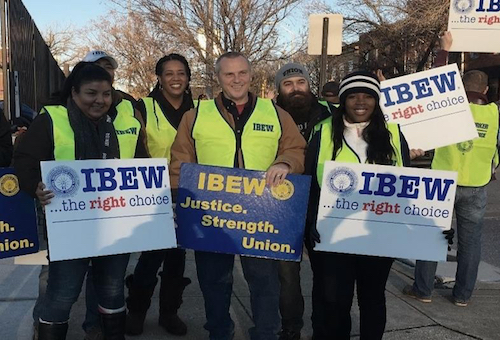A majority of people view the role of unions as a good
thing, says new research from Pew, and that’s good for working families
everywhere.

|
| Baltimore’s BGE employees voted in 2017 to join the IBEW, forming a new chapter, Local 410.
|
When unions are strong, the middle class is strong,” said International President Lonnie R. Stephenson. “Without us there to be a critical check on big business, those corporations will prioritize the bottom line above all else and working families will suffer.”
According to the Pew survey, 55 percent of Americans have a favorable impression of unions and 51 percent say the reduction in representation, “has been mostly bad for working people in the U.S.,” compared to only 35 percent who say it’s been “mostly good.”
While views of unions have fluctuated somewhat over the last 20 years, they have become more positive than they were during the Great Recession, a period of low support, Pew reported. A poll by Gallup, conducted in August 2017, found that 61 percent of those surveyed supported unions, the highest since 2003.
The pro-union majority in the Pew survey is comprised primarily of Democratic-leaning individuals, people of color and young people. Almost 70 percent of those on the left side of the political spectrum view the shrinking of labor unions negatively, along with 65 percent of black people and postgraduates and 56 percent of people under 30 – the only age group with a majority.
That young people tend to support unions was shown in another study by the Economic Policy Institute, released in January. That report found that 76 percent of the increase in union membership in 2017 came from people under 35.
This majority union support may be due to the increasing amount of evidence that shows how unions act as a counterbalance on income inequality.
A recent study by researchers from Princeton and Columbia analyzed how union membership rates relate to the income gap. What they found suggests that, when unions are strong, the gap shrinks and working families do better.
At labor’s peak, more than 30 percent of working people had union representation. That was back in the 1950s, when the income gap between the richest 1 percent and the rest of the country was far less cavernous than it is today. In 2017, only 11 percent of Americans could claim union membership.
As Mike Konczal writes in The Nation, “If we want to change whom our economy works for, we must change who gets to exercise power. And this paper makes it clear: There is power in a union.”
The AFL-CIO reported in April that more than 10,000 people joined together in union in just one week this year, and 700 of those came from the IBEW’s successful efforts to organize Atlanta Gas Light workers.
“You are now joining a brotherhood, and you’re going to have friends and family all across the United States and Canada,” Stephenson said in a video address to the new members. “We’re happy to have you aboard … and we’re going to get you that first contract.”